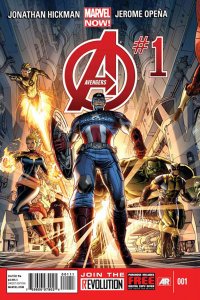THOR’S COMIC COLUMN: 2012 IN REVIEW
Well, there’s 2012 in the rearview mirror, and you knew that our hardy crew couldn’t let that pass without getting all retrospective n shit.
I asked everyone for their thoughts, with no instructions regarding specifics or formatting, and you will be pleased (I hope) to see that each member of the team came up with a different slant on summing up the year, so even though this is a long piece, I think you’ll find plenty of variety.
My thanks to the guys, of course, and to all the CHUD folk who read, and who offer comments: that’s the only currency in which we’re paid for our efforts, and all feedback is warmly appreciated.
Onward, True Believers!
***
2012 from ADAM PROSSER:
2012 was a potentially pivotal year for comics, for reasons that often had little to do with the comics themselves. Rather, it was a year in which the leaden footsteps of other media, Godzilla-style, created earthquakes that buffeted the comics industry to and fro. Probably the biggest are the still-reverberating purchase of Marvel by Disney, and now Lucasfilm’s purchase by the same company, which among other things threatens to snatch away the lucrative Star Wars license from Dark Horse after, what, two decades? There’s also, of course, the massive success of The Avengers, which could be argued as “more of the same” for Marvel, just as The Dark Knight Rises continues DC’s movie streak of having to put all its eggs in one Bat-sket. (I’m sorry. Blame that one on post-holiday stress.) There’s also the massive success of The Walking Dead, which arguably is almost as much of a multimedia triumph for Image comics.
And then, of course…the real breakthrough of digital comics in 2012. We’re probably too close to this even to be able to see how it’s going to shake out, but the words “game-changer” don’t seem inappropriate.
When it comes to the comics themselves, though, 2012 strikes me as a year where, after a few years of tumult, the publishers settled into a groove and we began to get a real sense of where they’re headed. Let’s break it down, shall we?
DC
Starting, sad to say, with the biggest trainwreck, the Lindsay Lohan of comics publishers if you will—the one that’s always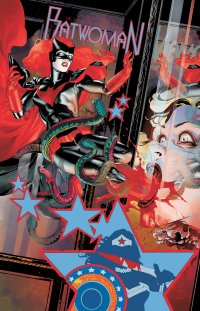 in the news, but not really for the best reasons. I haven’t exactly hid my feelings for DC’s current modus operandi, but when you crunch it all down into a yearly summary it’s even worse than I would have thought. The New 52 was confirmed as a desperation play, a completely hollow gimmick that’s shed most of its interesting smaller books while producing a top tier of mostly mediocre, samey efforts. Before Watchmen was even worse, an act of what I can only call auto-cannibalism. With the departure of Karen Berger, Vertigo looks like it’s being packed up and sold for scrap too, with the venerable Hellblazer ending and Constantine being stuffed down the greedy maw of the mainstream DCU, where the character’s free to sputter in sales and then be consigned to eternal limbo with DC’s other mountain of characters it owns yet never knows what to do with. If the big comics companies are aiming to become nothing more than IP farms, what happens when they start immolating those IPs?
in the news, but not really for the best reasons. I haven’t exactly hid my feelings for DC’s current modus operandi, but when you crunch it all down into a yearly summary it’s even worse than I would have thought. The New 52 was confirmed as a desperation play, a completely hollow gimmick that’s shed most of its interesting smaller books while producing a top tier of mostly mediocre, samey efforts. Before Watchmen was even worse, an act of what I can only call auto-cannibalism. With the departure of Karen Berger, Vertigo looks like it’s being packed up and sold for scrap too, with the venerable Hellblazer ending and Constantine being stuffed down the greedy maw of the mainstream DCU, where the character’s free to sputter in sales and then be consigned to eternal limbo with DC’s other mountain of characters it owns yet never knows what to do with. If the big comics companies are aiming to become nothing more than IP farms, what happens when they start immolating those IPs?
Along with Berger, DC shed a lot of talent, and will be shedding more—Jeff Lemire off Frankenstein (which is now being cancelled), J. H. Williams leaving Batwoman and the inexplicable e-firing and sudden rehiring of Gail Simone. Once again it all rests on the shoulders of Grant Morrison, whose work steadily declined in 2012, and Geoff Johns, who is Geoff Johns.
There are still bright spots in DC’s output—Manupaul’s The Flash is still very pretty, Scott Snyder is doing solid work, and last I checked getting China Mieville to write Dial H had produced an interesting, offbeat book—but these are seeming more and more like gussied-up deck chairs on the Titanic. If any of these moves, quality or otherwise, had produced massive sales and righted the company, I’d have been forced to acknowledge DC as some kind of evil geniuses, but the sales have been consistently mediocre overall, good enough to keep the company puttering along but not enough to make them seem like a stable corporate entity. Instead they seem like a group of museum guards trapped in the Louvre during a power outage, slowly throwing their cultural heritage on the fire to keep warm in half-hour increments, rather than working to actually solve the problem. And they’re almost out of stuff to burn.
MARVEL
As if to cosmically balance the scales, Marvel—able to bask in the reflected glory of its blockbuster movies, and 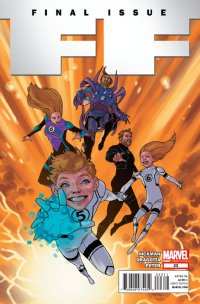 therefore, presumably, without the sword of Damocles hanging over its head (though this was its first full year under the watchful eye of the legendarily stingy Isaac Perlmutter, having the biggest pop culture characters in the world under your aegis presumably grants some protection)—took some interesting turns. The line started leaning away from the overwrought angst and “adult” storytelling that comics have been leaning on rather too heavily for a while now, and towards a more thoughtful, experimental style. Leading the way here was Jonathan Hickman’s FF, which ended this year, handing the reins of that and its sister book Fantastic Four over to another “big idea” guy, Matt Fraction, with so-far pleasing results. Likewise, we saw Kieron Gillen’s heartfelt run on Journey into Mystery end and Jason Aaron’s promising Thor: God of Thunder get started, Matt Fraction revive The Defenders as the Marvel U.’s “weird superteam”, Jason Aaron (again?) adding a dose of weirdness to the X-Men, and Matt Fraction (AGAIN?) turning Hawkeye, of all people, into a character who can support his own book. Of course, the waning days of the year also gave us the controversial Amazing Spider-Man #700 and the reboot of the book, which is going to have to walk a very fine tightrope not to fall into some of the ill-judged ickiness that comics seem to have trouble steering clear of.
therefore, presumably, without the sword of Damocles hanging over its head (though this was its first full year under the watchful eye of the legendarily stingy Isaac Perlmutter, having the biggest pop culture characters in the world under your aegis presumably grants some protection)—took some interesting turns. The line started leaning away from the overwrought angst and “adult” storytelling that comics have been leaning on rather too heavily for a while now, and towards a more thoughtful, experimental style. Leading the way here was Jonathan Hickman’s FF, which ended this year, handing the reins of that and its sister book Fantastic Four over to another “big idea” guy, Matt Fraction, with so-far pleasing results. Likewise, we saw Kieron Gillen’s heartfelt run on Journey into Mystery end and Jason Aaron’s promising Thor: God of Thunder get started, Matt Fraction revive The Defenders as the Marvel U.’s “weird superteam”, Jason Aaron (again?) adding a dose of weirdness to the X-Men, and Matt Fraction (AGAIN?) turning Hawkeye, of all people, into a character who can support his own book. Of course, the waning days of the year also gave us the controversial Amazing Spider-Man #700 and the reboot of the book, which is going to have to walk a very fine tightrope not to fall into some of the ill-judged ickiness that comics seem to have trouble steering clear of.
Still, as a guy who, historically, is more of a DC partisan, 2012 is the year that Marvel made me sit up and take notice, and not just by default. It seems like the House of Ideas is working hard to get that title back.
IMAGE
2012 was the year it seemed like Image could seriously compete with Marvel and DC, for the first time since the early 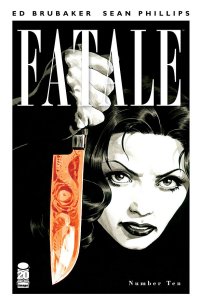 90s. I’m not sure exactly how the finances work over there—the company was founded on the idea that its creators would be able to keep the ancilliary profits—but surely the massive success of The Walking Dead is giving them SOME kind of boost, because they launched an ambitious line this year. Much has already been written about Brian K. Vaughan’s Saga, which marries the nerdiest of RPG-esque space opera with Vaughn’s usual heartfelt character work, and takes him satisfyingly out of his comfort zone. Grant Morrison released his first non-DC book in years, Happy, which seemed like a chance to vent his frustrations with the current state of comics, not that Morrison’s admitting to anything. Fatale garnered acclaim, The Manhattan Projects brought Jonathan Hickman’s loopy sensibility back to the publisher where he first got noticed, and Creator Owned Heroes made an attempt to match Dark Horse at the anthology game.
90s. I’m not sure exactly how the finances work over there—the company was founded on the idea that its creators would be able to keep the ancilliary profits—but surely the massive success of The Walking Dead is giving them SOME kind of boost, because they launched an ambitious line this year. Much has already been written about Brian K. Vaughan’s Saga, which marries the nerdiest of RPG-esque space opera with Vaughn’s usual heartfelt character work, and takes him satisfyingly out of his comfort zone. Grant Morrison released his first non-DC book in years, Happy, which seemed like a chance to vent his frustrations with the current state of comics, not that Morrison’s admitting to anything. Fatale garnered acclaim, The Manhattan Projects brought Jonathan Hickman’s loopy sensibility back to the publisher where he first got noticed, and Creator Owned Heroes made an attempt to match Dark Horse at the anthology game.
But the real, left-field triumph at Image was the resurrection of a number of Rob Liefeld properties. Of the three I paid attention to, Supreme brought some much-needed closure to Alan Moore’s run, though Erik Larsen was bound to disappoint while following in the footsteps in the master. Glory by Ross Campbell and Josh Keatinge, provides a much more original take on the same Moore/Liefeld dynamic, though it’s wrapping up too soon. And Brandon Graham’s Prophet is, simply put, one of the best comics in years, a truly unique creation built around a fully immersive world.
DARK HORSE
Dark Horse? More like Work Horse, am I right?
(Crickets)
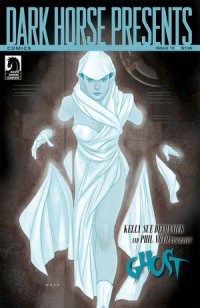 There isn’t much to say about the venerable publisher of Hellboy/BRPD, Conan, and The Goon, except that they continued to publish those books (after a bit of a lull, Brian Wood and Becky Cloonan brought the eternal barbarian back to a level of quality almost worthy of Kurt Busiek and Cary Nord’s revamp). Dark Horse continues to put out solid tie-in books, with Buffy and its ilk being the big ones (Star Wars? Not for much longer, due to certain current events…)
There isn’t much to say about the venerable publisher of Hellboy/BRPD, Conan, and The Goon, except that they continued to publish those books (after a bit of a lull, Brian Wood and Becky Cloonan brought the eternal barbarian back to a level of quality almost worthy of Kurt Busiek and Cary Nord’s revamp). Dark Horse continues to put out solid tie-in books, with Buffy and its ilk being the big ones (Star Wars? Not for much longer, due to certain current events…)
The big event for Dark Horse was the revival of the top-shelf anthology Dark Horse Presents, which even with the limitations of the anthology format has delivered some really terrific work, particularly by Carla Speed McNeil and Richard Corben.
They may not always burn up the charts, but in an industry that’s perpetually flying from crisis to crisis, I always find it comforting to know that Dark Horse is plugging away reliably, continuing to put out books, and probably will do so until and unless the whole industry collapses.
THE REST
Probably the biggest story among the smaller publishers was BOOM!, which lost its lucrative Disney properties, including (alas) Roger Langridge’s excellent Muppets book, but gained a new, zeitgeist-grabbing hit in the form of Adventure Time and its attendant spinoffs. IDW snapped up The Rocketeer and produced some solid comics, as well as continuing to pump out those Star Trek and Doctor Who books that clearly a lot of people are reading, though those people aren’t me. Dynamite went all-in on its pulp revival comics, as well as continuing to put out off-brand Tarzan and John Carter comics thanks to the vagaries of copyright law, which I find endlessly amusing.
Oh, and then there was Archie, which, among many other odd turns (many of them uniquely inventive for a traditionally conservative publisher), gave their first openly gay character, Kevin Keller, his own book. Some people call it cynical headline-grabbing, but the results, and the response, have been too genuine to see it as anything but real progress.
***
2012 from GRAIG KENT:
Best Comic
Saga (Image) – I’m sure there are books, ongoing, mini, original graphic novels and otherwise that are, indeed, better 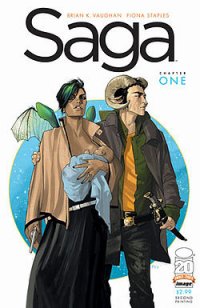 than Saga, but Brian K. Vaughan and Fiona Staples’ wildly imaginative blend of fantasy, science fiction, war and family drama is one of few I felt compelled to thrust upon others. It’s not because it’s so good, but because it’s so likable. I fear the critical praise it receives may spawn a backlash of hipsters and internet trolls who roll their eyes at this book-du-jour, but anyone who has read Y: The Last Man, Ex Machina, and/or Runaways knows that Vaughan understands long form storytelling, great characters and character dynamics, and is capable of delivering something unique, compelling and entertaining on a monthly basis. And Ms. Staples’ work is a gift, just stunning.
than Saga, but Brian K. Vaughan and Fiona Staples’ wildly imaginative blend of fantasy, science fiction, war and family drama is one of few I felt compelled to thrust upon others. It’s not because it’s so good, but because it’s so likable. I fear the critical praise it receives may spawn a backlash of hipsters and internet trolls who roll their eyes at this book-du-jour, but anyone who has read Y: The Last Man, Ex Machina, and/or Runaways knows that Vaughan understands long form storytelling, great characters and character dynamics, and is capable of delivering something unique, compelling and entertaining on a monthly basis. And Ms. Staples’ work is a gift, just stunning.
Runner Up/MIND MGMT
Best DC Comic
Wonder Woman – because we have to acknowledge “the Big 2″… I started out reading nearly two-thirds of “The New 52” in its first few months. That pull list has dwindled to about 10 regular monthlies, with the axes sharpened and getting ready to be swung again. But Wonder Woman is the perfect encapsulation of what I had hoped “The New 52” would be. Standing aside from continuity and telling its own story within a “shared universe”, redefining the character for a modern age and utilizing only the DCU characters it’s top tier creative team of Brian Azzarello, Cliff Chiang and Tony Akins want to use (and generally looking to mythology or else creating their own). Azzarello is constructing a new mythos for Greek pantheon with Diana at the center, and is currently working Kirby’s New Gods into the fold. It’s smart, it’s fun, and Wonder Woman is just so indelibly kick-ass.
Runner Up/Smallville, Season 11 (no, I’m not kidding)
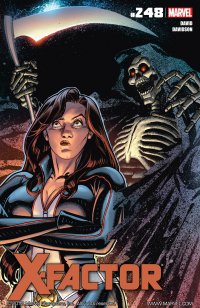 Best Marvel Comic:
Best Marvel Comic:
X-Factor – Okay, I need to be brutally honest, X-Factor is the only Marvel title I regularly read on a monthly basis. I typically trade wait for most of the Marvel books I read (Fantastic Four, FF, Daredevil, that sort of thing, so Hawkeye will have to wait for trade). The reason I don’t trade wait on X-Factor? Because Peter David (speedy recovery, mate) cranks out roughly 16 issues a year of absolutely classic-style comic bookery. David, a rotating cast of artists and his absolutely mammoth cast of cast-away mutants stand on their own two feet, not worrying about the rest of the 616, only what’s before their faces. Marvel does a better job of compartmentalizing its books than DC does, but X-Factor more than almost any other title from any “shared universe” publisher marches to its own unique drum (even when its been forced into crossovers in the past). If this X-Factor were on TV, it would be can’t miss every week. As it is, it’s can’t miss/top of the pile every issue.
Runner Up/Ultimate Spider-Man
Best Publisher:
Image – Image has, for the past few years, been putting out a vast assortment of titles, trading in a vast assortment of genres, but in 2012, it took a decidedly bold step forward in the quality level. Having a solid stable of ongoing books and roping in some quality talent from other smaller publishers and even the Big 2 has really given them life. Whereas it seemed in the past that Image would print pretty much anything to see what would hit, it would appear now that they’re “curating” their line-up, so to speak, so that it’s all very complementary, without stepping on each others toes. That I buy more Image titles than any other publisher in a given month is, to me, the biggest testament to how good the material is. It’s so good, there was no runner up. This was far and away Image’s year.
Best Writer:
Jonathan Hickman (FF, Fantastic Four, Ultimates, Manhattan Projects, Avengers) – quite simply there’s no 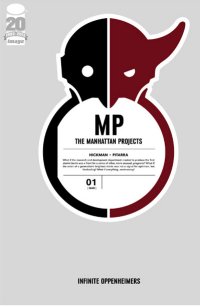 other writer who I’m so uniformly impressed with and entertained by. From the first issue of The Nightly News half a decade ago I knew he was something special, but I never imagined he would be this great both at creator-owned AND big-company superhero stuff. He understands epic storytelling without sacrificing character, his work can be profound and beautiful, sentimental and funny. That he was offered perhaps comics’ most prominent title (at the moment) is certainly recognition of what I already know, he’s simply the best out there right now.
other writer who I’m so uniformly impressed with and entertained by. From the first issue of The Nightly News half a decade ago I knew he was something special, but I never imagined he would be this great both at creator-owned AND big-company superhero stuff. He understands epic storytelling without sacrificing character, his work can be profound and beautiful, sentimental and funny. That he was offered perhaps comics’ most prominent title (at the moment) is certainly recognition of what I already know, he’s simply the best out there right now.
Runner Up/Brian Azzarello (Wonder Woman, Spaceman)
Best Artist:
Frazier Irving (The Shade, Masters of the Universe: The Origin of Skeletor, Batman Inc., various covers) – This is purely my own personal preference coming through. I just adore Irving’s work so thoroughly that even though he didn’t really have any ongoing series work, his three issue stint on The Shade maxi-series was some of his best while he elevated an already surprisingly good script for The Origin of Skeletor to greatness with his brilliant digitally constructed compositions. I’m an Irving fan for life, and as witnessed this year, he’s always going to deliver even on titles that aren’t the prominent and elevate them as a result.
Runner Up/Fiona Staples
Best New Artist:
Riley Rossmo (Debris, Bedlam) – though he’s been in the game for a couple years now (Cowboy, Ninja, Viking most notable previously), Rossmo really made an impression this year with not one, but two very distinct Image series. Like any good artist, it takes a few years of steady professional work to shake off the influences and truly come into one’s own style, but Rossmo’s hit his and it’s unique, charming and gorgeous.
Best Original Graphic Novel:
 Trinity: A Graphic History of the First Atomic Bomb (Hill and Wang) – to be honest,I wasn’t overly enthused with most of the original graphic novels I read this year. There were so many great new series and mini-series this year that there seemed, comparatively, a lack of really great, powerful, dramatic long-form one-shots. Of course I stick mainly to genre offerings and don’t delve into the ‘artier’ publishers as frequently, but Trinity was a brilliant debut from Jonathan Fetter-Vorm, bringing a lot of context and perspective to the construction of atomic weaponry, the decision to use it, and the arms race that followed. It’s educational, yes, but fascinating and,at times, appalling. Easily one of the best things I read all year.
Trinity: A Graphic History of the First Atomic Bomb (Hill and Wang) – to be honest,I wasn’t overly enthused with most of the original graphic novels I read this year. There were so many great new series and mini-series this year that there seemed, comparatively, a lack of really great, powerful, dramatic long-form one-shots. Of course I stick mainly to genre offerings and don’t delve into the ‘artier’ publishers as frequently, but Trinity was a brilliant debut from Jonathan Fetter-Vorm, bringing a lot of context and perspective to the construction of atomic weaponry, the decision to use it, and the arms race that followed. It’s educational, yes, but fascinating and,at times, appalling. Easily one of the best things I read all year.
Best Collected (HC or TPB):
Spaceman HC (Vertigo) – Brian Azzarello`s curious plunge into the world of the future made for an intriguing 9-issue mini-series, but in some respects the serialized nature of its initial publishing did the titles and the readers a disservice. Azzarello`s manufacturing of a unique future dialect is one of the book`s key draws, a hybrid mix of redneck drawl and texting/L33T-speak that is ingenious in its design. There’s a viable etymology to it, and not just a whole bunch of gibberish, and while it’s not the easiest to read, once you’re immersed, it becomes plain as day. Azzarello’s partnership with his 100 Bullets co-creator seems to be a second-nature deal now. The two work immaculately well together, and Risso has one of the most uniquely expressive styles which imbues his characters with a life that can only exist in comic pages. There’s such weight to his inks but it’s balanced so well by the broad physical and facial mannerisms of his characters. Such a charming read.
Runner Up/Flex Mentallo
Best Web Comic:
Oglaf [Oglaf.com] – Totally not safe for work, or children, or stuck-up stickybeats, but there’s no other comic book that understands so well the humour in sex or fantasy as well as Oglaf does. The fact that it combines sex AND fantasy so humourously, well, is kind of embarrassing to anyone else that’s tried it. This is the Anchorman or Black Dynamite or Arrested Development or Archer of fantasy porn comics. All those terribly unfunny “porn parodies” from the big porn companies need to stop now and see how porn comedy is done (and for that matter, most of the major Hollywood and television studios need to read this to see how funny is done). Hilarious, arousing and exceptional in every regard.
***
2012 from D. S. RANDLETT:
The Year of The Relapse
by D.S. Randlett (@dsrandlett)
Like it or not, 2012’s defining event happened late in the summer of 2011. DC’s New 52 relaunch has been a mixed  success (to put it kindly) creatively, and the strong initial sales didn’t hold. It’s easy enough to explain: with the exception of Batman their flagship series didn’t have very “grabby” stories. Justice League‘s first arc was a pointless dust up that wasted the New Gods, having Darkseid just show up as basically some random heavy. After its first issue, Action Comics became a really uneven series that has rarely lived up to the author’s affection for Superman, even if it is finally starting to fall into place. But the relaunch did show that DC was still a company that was willing to let some risks be taken within its line. Swamp Thing and Animal Man were sleeper hits that really helped the mainline DCU recover some of the weirder elements that were the foundation of the Vertigo label way back when, with it all sort of coming to a head in Azzarello/Chiang/Akins’ superlative Wonder Woman run.
success (to put it kindly) creatively, and the strong initial sales didn’t hold. It’s easy enough to explain: with the exception of Batman their flagship series didn’t have very “grabby” stories. Justice League‘s first arc was a pointless dust up that wasted the New Gods, having Darkseid just show up as basically some random heavy. After its first issue, Action Comics became a really uneven series that has rarely lived up to the author’s affection for Superman, even if it is finally starting to fall into place. But the relaunch did show that DC was still a company that was willing to let some risks be taken within its line. Swamp Thing and Animal Man were sleeper hits that really helped the mainline DCU recover some of the weirder elements that were the foundation of the Vertigo label way back when, with it all sort of coming to a head in Azzarello/Chiang/Akins’ superlative Wonder Woman run.
I could go on about the first full year of the New 52, but I only begin with it for two reasons. One: It got me reading comics (and not just DC) again, and two: It solidified digital distribution as a viable means of distributing this content. The two go hand in hand. I don’t live in a rural area, but the nearest comic shop is forty five minutes away from me, and out of the way of my typical haunts. I love comics, and brick and mortar stores, but adding time to my commute after a long day is a big disincentive. With the closure of many stores before digital distribution of comic books was even a whiff of an idea in the industry, I can imagine that this was the case for many other people. There’s still a long way to go, and I do worry about the shops out there, but in terms of content I think that universal availability is a good thing, as it eventually shifts the publishers’ focus squarely on content.
And what of the content? As ever, this has been a year with its share of badness and mediocrity. If anything, 2012 was Image and Dark Horse’s year, but I lost count of how many of Image’s new series felt like rejected pitches for TV shows. I eventually found out that Mind the Gap actually was conceived as a television show, and summarily rejected. And I could see why, because it just wasn’t very good, and series series like Mind the Gap don’t really work as comic books, failing to take advantage of the medium’s unique vocabulary. But Image also did get behind Brandon Graham (Prophet, Multiple Warheads), which alone would have made them own the year in my mind. Graham is a comic book guy through and through, one of the few currently working artists who thinks about how to use the medium to its full capability. Giving a talent like that a bigger platform, and letting him follow through on his own terms, is to be commended. And hey, if you don’t like Graham’s work, there’s always Saga, another genuinely great series that seeks to be, first and foremost, a thrilling reading experience unique to the medium.
 Dark Horse didn’t get behind a new talent in quite the same way or with quite the same gusto as Image, but they have quietly been shaking up their line. For the past five years they’ve been the house that Star Wars, Hellboy, and Conan built. It’s not like those titles and their spin offs have been particularly bad at all. Hell, the Star Wars miniseries Agent of the Empire turned out to be a surprise favorite of mine, and Brian Wood’s rebooted Conan has been a delight. But Dark Horse allowed their creative stable to explore different sorts of genres than the brand of pulp and horror that they’ve been, and continue to be, churning out. Still, the reemergence of Dark Horse Presents and Concrete, along with the debut of new, and very different series like The Massive, Mind MGMT, and my favorite of the year, The Creep, signal a return to the publisher’s foundations of being a place open to creators rather than a place with a house style. But then, that’s the icing. The cake is the fact that Dark Horse has reclaimed its stake in publishing genre stories that are humane, honest, and well crafted.
Dark Horse didn’t get behind a new talent in quite the same way or with quite the same gusto as Image, but they have quietly been shaking up their line. For the past five years they’ve been the house that Star Wars, Hellboy, and Conan built. It’s not like those titles and their spin offs have been particularly bad at all. Hell, the Star Wars miniseries Agent of the Empire turned out to be a surprise favorite of mine, and Brian Wood’s rebooted Conan has been a delight. But Dark Horse allowed their creative stable to explore different sorts of genres than the brand of pulp and horror that they’ve been, and continue to be, churning out. Still, the reemergence of Dark Horse Presents and Concrete, along with the debut of new, and very different series like The Massive, Mind MGMT, and my favorite of the year, The Creep, signal a return to the publisher’s foundations of being a place open to creators rather than a place with a house style. But then, that’s the icing. The cake is the fact that Dark Horse has reclaimed its stake in publishing genre stories that are humane, honest, and well crafted.
The New 52 got me reading comics again, but it hasn’t been what’s made me stick around. Rather, it’s been the shifts in the market, and in turn what those shifts have allowed this year to be: the year of the creator. I hope that there are more years like this.
***
2012 from DEVON SANDERS:
Favorite New Series
Glory (Image Comics)
2012 was the year where two things I thought would never happened, happened and both involved Rob Liefeld. DC 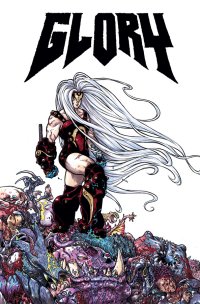 Comics, a company that just seems lost, treated him so shoddily that he very publicly up and left and I actually sympathized. I felt for Rob Liefeld. I understood something Rob Liefeld did. I felt it in my soul. I did.
Comics, a company that just seems lost, treated him so shoddily that he very publicly up and left and I actually sympathized. I felt for Rob Liefeld. I understood something Rob Liefeld did. I felt it in my soul. I did.
The second was that Rob Liefeld got out of his own way and let other people step up and run the show. One of the results was Glory, one of the best comics I’ve read in a very long time. This is amazing especially when you consider what writer Joe Keatinge had to work with. Glory was nothing but a weak Wonder Woman pastiche that had the weird fortune of having one single issue written by Alan Moore at torture porn factory, Avatar Press. Liefeld and Keatinge smartly have focused on expanding Glory’s mythology, moving it away from its superhero origins and firmly into the realm of science fiction. Glory is now cast into a world I can only describe as “Game of Thrones but with giant spaceships and lots and lots of fistfighting”. Glory is gloriously full of fistfights in outer space and more importantly, valid reasons for them. Good on you, Joe Keatinge. Especially spectacular is series artist Ross Campbell. With every issue he redesigns Glory and with every issue he somehow continues to just get better. Glory is simply stellar work.
Favorite Comics Moment of 2012
Marvel Comics is just this wondrous machine. The universe changes constantly but just enough so that they can easily put it back where they want it. Well, following their not so successful relaunches of two years ago, Marvel rebooted and relayed, moving talent and characters all across the the Marvel Universe and what resulted was, frankly, some of the most enjoyable superhero comics reading I’ve done in a long time.
One of the bits of wondrous they loosed unto the reading public was writer Jonathan Hickman, the spiritual successor to futurist Warren Ellis, taking over the Avengers franchise. The result was a moment in issue one that literally gave me the chills.
In the final four pages of Avengers #1, we see a seemingly diminished Captain America inspire simply by being.
“Our Captain spoke and gave the idea form. He said the words, and made it real. He said… Assemble at dawn. And how could we not? We were Avengers.”
And with those words, those wondrous words, Hickman summed up perfectly why there are heroes.
Favorite Graphic Novel of 2012
The Nao of Brown (SelfMadeHero)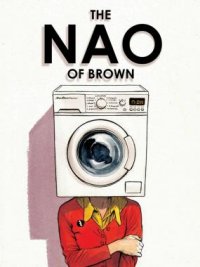
My words will not do this book justice. All I can tell you is this; at the 2012 Small Press Expo, a friend of mine, excitedly, showed me this book, The Nao Of Brown. My heart changed and it felt like a baptism. Within 2 minutes, I’d bought the book and conversed with the writer/artist Glyn Dillon. The art was lush, recalling the best bits of master artist Milo Manara. You felt these characters. You wanted to know them.
Glyn Dillon, through his work, turned me evangelical. I was showing the book off. My friends deserved to have this book in their libraries, on their nightstands, on their shelves.
For nearly an hour, I was bringing as many eyes as possible over to Dillon’s table and for the weeks following my reading Nao, it stayed with me.
That’s what a novel should do. It has stayed with me and I am better for it.
***
2012 from JEB D:
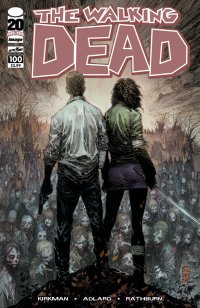 Interesting year for comics. Single-issue direct-market sales, long overdue for collapse, rebounded somewhat this year (due largely to the Big 2 finally coming clean that their best sales strategy has always been to just renumber the damn things), while the continued shrinking of the retail bookstore market (two B&N stories within a ten-minute drive of my house closed last week) put a big hurt on trade paperback sales (long supposed to be the industry’s savior). The biggest media-driven comic event of the year, both in single-issue and collected form, wasn’t The Avengers or Dark Knight Rises, but The Walking Dead, which suggests that the film-boosting-comic-sales synergy that the Big 2 are striving for works best in a medium like TV that matches the serialized storytelling style of monthly-issue comics. Digital? Still more the future, but I’m about to take the plunge, and will likely do a lot of my reading that way in 2013.
Interesting year for comics. Single-issue direct-market sales, long overdue for collapse, rebounded somewhat this year (due largely to the Big 2 finally coming clean that their best sales strategy has always been to just renumber the damn things), while the continued shrinking of the retail bookstore market (two B&N stories within a ten-minute drive of my house closed last week) put a big hurt on trade paperback sales (long supposed to be the industry’s savior). The biggest media-driven comic event of the year, both in single-issue and collected form, wasn’t The Avengers or Dark Knight Rises, but The Walking Dead, which suggests that the film-boosting-comic-sales synergy that the Big 2 are striving for works best in a medium like TV that matches the serialized storytelling style of monthly-issue comics. Digital? Still more the future, but I’m about to take the plunge, and will likely do a lot of my reading that way in 2013.
I haven’t seen any economic pundits speculate on this, but I wonder if one indicator of the returning health of the US economy might be the fact that, according to everything I’ve seen, while individual comic sales rebounded in 2012, they did so while not actually adding many new readers (again, save for Walking Dead): evidently the average comic fan had a few more bucks of disposable income in his pocket this year.
So, to my year in comics. As we’ve mentioned before, this column gets virtually no freebies or advance previews, which, along with the tight deadline, means that we pretty much only review what we can afford to buy or borrow, and none of us can really get anything close to a comprehensive view of what’s out there (that’s why several of the comics on my list are titles I never actually got around to writing about this year, since I came to them late). I’m grateful to Adam, Bart, Dan, Devon, and Graig for getting me to try a few titles that I might have been reluctant to lay out coin for otherwise.
On a purely a statistical basis, I’m sure that my list below misses out on more good comics than it includes.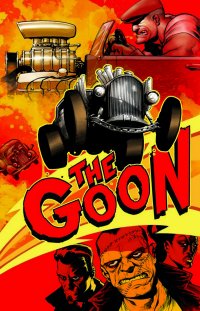
Outside the confines of my personal (and, admittedly, fluctuating) “top ten,” below, there was reliable quality and enjoyment to be had from books like Fables (and, to lesser degree, Fairest), The Goon, Mignola’s Baltimore tales and Hellboy-verse, Powers, The Unwritten, Fatale, Batwoman, Empowered, The Shadow, Atomic Robo, and as strong a slate as Marvel has fielded in years: Waid’s Daredevil (and Bendis’ Daredevil: End of Days), Brubaker’s Captain America, David’s X-Factor, DeConnick’s Captain Marvel, Hickman’s Fantastic Four, Rucka’s Punisher, Ennis’ Fury MAX, and Aaron’s Wolverine and Punisher MAX (sad how many of them are ending), any of which could have easily made the list (and no offense to the generally excellent artists of those books, but corporate comics is definitely a writer-focused enterprise these days). There’s always a few I tradewait, so at this point I don’t yet have anything to say about well-regarded titles like Great Pacific, Prophet, Happy, or The Massive, to name a few (to say nothing of Before Watchmen, of which I’ve read exactly one issue to this point).
And to deal with one elephant in the room: I am, so far, somewhat underwhelemed by Saga. Obviously, a book this ambitous, from creators this talented, is several cuts above the average, and I’d recommend any reader at least give it a try, but I can’t help feeling that underneath Staples’ jumble of arresting images, I’m reading characters just ported over from Y: The Last Man and Runaways, with a portrayal of the expecting/new-parent experience not that far advanced from Baby Blues, and a central core that rarely delves deeper than “diversity is good, dammit!.” I have enough faith in Vaughan to keep reading to see where this goes, but, then, long-term development tended to flatten some of the intrigue of Y, which lost much of its momentum in the late going, until the very end, so I’m not sure how confident I can be on that.
So anyway, on to the comics reading that seems to have stuck with me the most as 2012 wrapped up. Interesting how few actual issues this list covers: many of these are series that were just beginning, or just ending, in 2012, so it’s possible this list would have looked quite different if I’d been comparing a full year’s run of some of these to a year’s worth of Fables or Daredevil. Or, you know, maybe not.
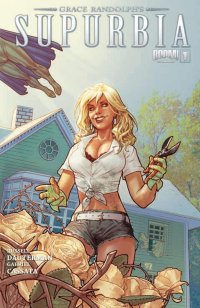 11. The Twelve (Marvel). I’m tossing in the final issues of The Twelve, though the ridiculous delays mean that this comic really should have been part of a 2011 list, if not 2010, so it’s here on a technicality. The series featured a generally compelling script from J. Micheal Straczynski, but Chris Weston’s art was so blindingly off the charts that it nearly overwhelmed the story.
11. The Twelve (Marvel). I’m tossing in the final issues of The Twelve, though the ridiculous delays mean that this comic really should have been part of a 2011 list, if not 2010, so it’s here on a technicality. The series featured a generally compelling script from J. Micheal Straczynski, but Chris Weston’s art was so blindingly off the charts that it nearly overwhelmed the story.
10. Supurbia (Boom! ). It’s possible I’m giving Grace Randolph bonus points for “degree of difficulty” here: finding something new to do with the “ordinary lives of superheroes” trope can’t be easy. And it’s true that the ongoing version of her “real desperate housewives of sort-of-the-Justice-League” has started more slowly than last year’s tightly focused miniseries did. But the suburban world-building here is just as effective as that of a good fantasy or SF series, and the character dynamics make this a cast that is a delight to spend time getting to know. Russell Dauterman’s art is appropriately lively.
9. Saucer Country (Vertigo). There aren’t too many pop culture memes I’m more tired of than alien-abduction-Roswell stories, or giant conspiracies; add to both of those the challenge of a quintessentially British writer working in the idiomatically American framework of a Presidential campaign in a Southwestern setting, and I was hardly the target audience for this book. On the other hand, Paul Cornell has been surprising me ever since Wisdom, and I should have known that he’d confound my expectations yet again: the depth of the plotting, and distinctive character work, the interlocking mysteries with answers being parceled out slowly and teasingly, and his love of the weirdly absurd, have made this compulsive reading. It’s a little jarring when Cornell trips up here and there (he may not realize that the designation of “Democrat” party rather than “Democratic” is a Gingrich/Limbaugh attempt to diminish their opposition, not a term that Democrats themselves use), but his plotlines and and characterizations continue to reveal new layers every time. Ryan Kelly’s art is an effective vehicle for Cornell’s storytelling, if nothing groundbreaking.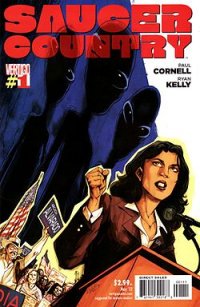
8. The Creep (Dark Horse ). If the key to great detective writing is to have a protagonist at least as damaged as his clients, then John Arcudi’s Oxel is perfectly realized for the comics: physically disfigured and in constant pain, while pursuing answers regardless of the cost to himself and those he cares about. Artist Jonathan Case doesn’t go overboard with the noir shadings, rendering the story’s bleakness in a straightforward way. My only real reservation about this heartbreaking mystery tale is the fact that the decision to tell the story in a quick four issues (plus a 0 issue that more or less rendered itself redundant) required a fairly extensive info-dump at the end to resolve things; otherwise, as a comic mystery as gripping as the best of Brubaker.
7. The Manhattan Projects (Image). It’s a good time for slightly mad sci-fi in the comics, and Jonathan Hickman’s work here, with the Quitely/Darrow influenced art of Nick Pitarra, is a cynically wild ride. One of the things I initially found annoying about this black-comic alternate history of the lethal technologies of the 20th century was its blithe willingness to mislead, mixing real history with ludicrous EC-horror-comic tropes; now, it’s one of the things I love most about it.
6. Mind MGMT (Dark Horse ). Like Brubaker’s Criminal, Matt Kindt’s weirdly fascinating mystery series wants to distinguish itself by being crammed full of content that won’t be rendered redundant by eventual trade collection; Kindt, however, takes that idea farther with web integration and puzzles-within-puzzles, for a rich, immersive experience. At times, the concept seems more interesting than the storyline, but his artwork has an engagingly primitive quality that suggests a tourist at a sidewalk cafe, sketching out strange events they see in passing, but can’t quite understand. Conspiracies again, but I’ll roll with it.
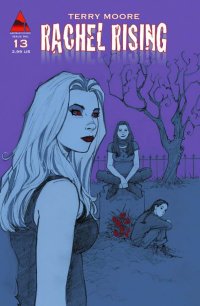 5. Rachel Rising (Abstract Studio). Terry Moore’s Echo was an effective transfer of his skill at illustrating relationships to a superhero/sci-fi setting; Rachel Rising ups the ante into black horror. Moore’s expert pacing and starkly beautiful art underline the story’s bloody, unsettling mysteries, his dialogue is sharp, his facial work, as always, unsurpassed. I’m a little uncertain about his decision to make this an ongoing; Echo‘s thirty issues seemed exactly right for that story, and Rachel Rising might benefit from a similar constraint.
5. Rachel Rising (Abstract Studio). Terry Moore’s Echo was an effective transfer of his skill at illustrating relationships to a superhero/sci-fi setting; Rachel Rising ups the ante into black horror. Moore’s expert pacing and starkly beautiful art underline the story’s bloody, unsettling mysteries, his dialogue is sharp, his facial work, as always, unsurpassed. I’m a little uncertain about his decision to make this an ongoing; Echo‘s thirty issues seemed exactly right for that story, and Rachel Rising might benefit from a similar constraint.
4. Harvey Pekar’s Cleveland (Top Shelf). I wonder if this one tended to slip past a lot of readers expecting the Paul-Giamatti-Letterman-guest-star curmudgeon version of Pekar; instead, with wonderfully eloquent art from Joseph Remnant, it’s Pekar in a quiet mode, at his most human and disquisitive: it shouldn’t take a genius to make us realize that the history of the people inhabiting the Clevelands of the world can repay investigation every bit as much as the New Yorks or Londons. Poignant and endlessly fascinating, and a fitting farewell from one of comics’ most unique minds.
3. Hawkeye (Marvel). At this point, I don’t know what more needs to be said about what Matt Fraction and David Aja are doing with this series. Let me quote my own review of issue #3: “Okay, superhero comics fans, it’s put up or shut up time: for years, we’ve been demanding that the Big 2 bring us quality comics that aren’t weighed down by accretions of continuity, that stand apart from the endless parade of crossovers and events, that tell great done-in-one-issue stories. This is precisely what Matt Fraction, David Aja, and Matt Hollingsworth are doing here, so we owe it to them, and ourselves, to go out and buy the darn thing!” From what I hear, it seems we have been. Go us.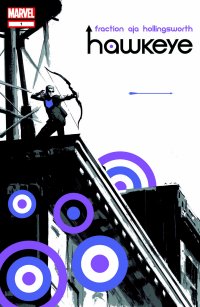
2. Scalped (Vertigo). Quoting myself again on the finale of Jason Aaron and R.M. Guera’s bleak modern Native American noir: “… providing closure to most of the characters doesn’t keep Aaron and Guera from ramping up the action yet again: the opening pages of #60 are typically brutal and uncompromising. From there, we get a few more revelations, some bitter and bittersweet farewells, a hint of transformation and the sense that a form of justice sometimes comes to the deserving… the throughline from Indian Country, the first story arc… to the concluding Trail’s End, has been as involving and moving as any comic I’ve read in years. It may hurt to know that I won’t be reading new installments of Scalped any more, but honestly, it had to end this way.” Crime writing as compelling as any of today’s most respected novelists.
1. Journey Into Mystery / FF (Marvel). In the same week this fall, two of Marvel’s most distinctive and imaginative series came to a close, in ways that left more than a few readers bereft. Jonathan Hickman’s FF provided cheerfully wild flights of imagination and lovely grace notes to his epic run on Fantastic Four (with lovely art from the likes of Juan Bobillo and Andre Araujo, among others), while Kieron Gillen’s Journey Into Mystery was fantasy shot through with perception, humor, and romance, a story of gods and humans with the compelling plotting of Fables, and the emotional resonance of Sandman. And while both series have resumed/continued in capable hands (Matt Fraction and Michael and Laura Allred have taken over FF, while Kathryn Immonen and Valerio Schiti are bringing a sharp, snappy edge to JIM), there is one terrible sense of loss: JIM cover artist Stephanie Hans was finally given the chance to do the interiors on Gillen’s concluding issue, and turned in the most breathtakingly beautiful single comic I read all year; it’s nearly criminal to think we won’t get another issue of JIM from her.
***
Ever had one of those teachers who stuck a trick question at the end of the instructions for an exam, to see if you were actually reading the whole thing? Well, if you’ve made it this far, I’m assuming you’ve got an unhealthy level of interest in what we’re up to here… and, as it happens, the Thor crew is looking to add a couple of new members, to lighten some of the workload, and get new voices and new perspectives for our readers. So, if you think you might be interested in being a conributor (unpaid, and with no promise of any free comics), drop me an email: jebdel@gmail.com, or PM me here at CHUD.
